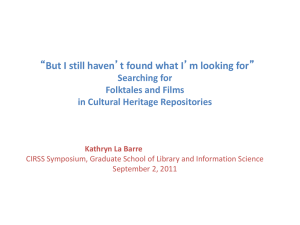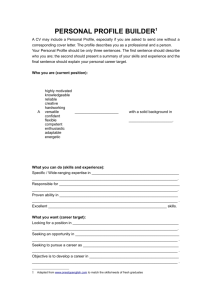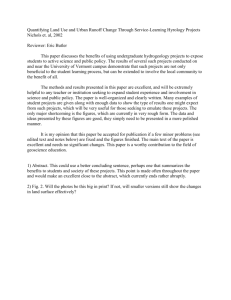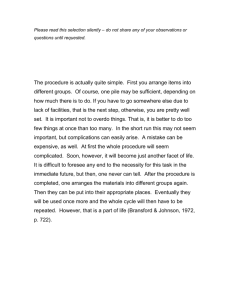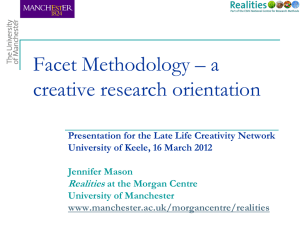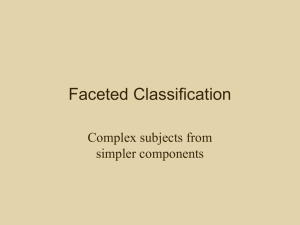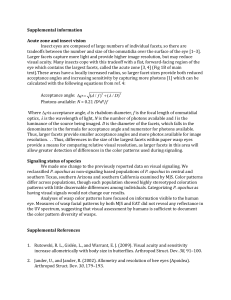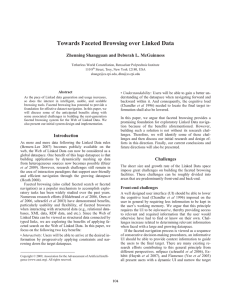Task Type and a Faceted Classification of Task
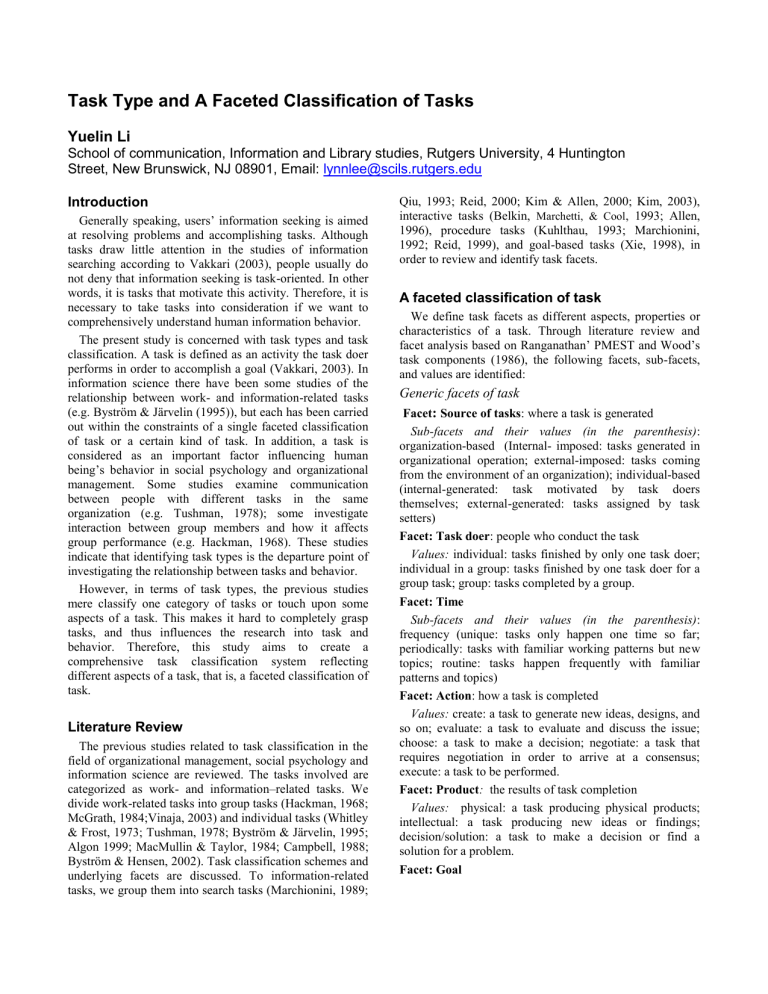
Task Type and A Faceted Classification of Tasks
Yuelin Li
School of communication, Information and Library studies, Rutgers University, 4 Huntington
Street, New Brunswick, NJ 08901, Email: lynnlee@scils.rutgers.edu
Introduction
Generally speaking, users’ information seeking is aimed at resolving problems and accomplishing tasks. Although tasks draw little attention in the studies of information
Qiu, 1993; Reid, 2000; Kim & Allen, 2000; Kim, 2003), interactive tasks (Belkin, Marchetti, & Cool , 1993; Allen,
1996), procedure tasks (Kuhlthau, 1993; Marchionini,
1992; Reid, 1999), and goal-based tasks (Xie, 1998), in order to review and identify task facets. searching according to Vakkari (2003), people usually do not deny that information seeking is task-oriented. In other words, it is tasks that motivate this activity. Therefore, it is necessary to take tasks into consideration if we want to
A faceted classification of task
We define task facets as different aspects, properties or comprehensively understand human information behavior.
The present study is concerned with task types and task classification. A task is defined as an activity the task doer performs in order to accomplish a goal (Vakkari, 2003). In information science there have been some studies of the relationship between work- and information-related tasks
(e.g. Byström & Järvelin (1995)), but each has been carried out within the constraints of a single faceted classification of task or a certain kind of task. In addition, a task is characteristics of a task. Through literature review and facet analysis based on Ranganathan’ PMEST and Wood’s task components (1986), the following facets, sub-facets, and values are identified:
Generic facets of task
Facet : Source of tasks : where a task is generated
Sub-facets and their values (in the parenthesis) : organization-based (Internal- imposed: tasks generated in organizational operation; external-imposed: tasks coming considered as an important factor influencing human being’s behavior in social psychology and organizational management. Some studies examine communication between people with different tasks in the same from the environment of an organization); individual-based
(internal-generated: task motivated by task doers themselves; external-generated: tasks assigned by task setters) organization (e.g. Tushman, 1978); some investigate interaction between group members and how it affects group performance (e.g. Hackman, 1968). These studies indicate that identifying task types is the departure point of investigating the relationship between tasks and behavior.
Facet: Task doer : people who conduct the task
Values: individual: tasks finished by only one task doer; individual in a group: tasks finished by one task doer for a group task; group: tasks completed by a group.
However, in terms of task types, the previous studies
Facet: Time mere classify one category of tasks or touch upon some aspects of a task. This makes it hard to completely grasp tasks, and thus influences the research into task and behavior. Therefore, this study aims to create a
Sub-facets and their values (in the parenthesis) : frequency (unique: tasks only happen one time so far; periodically: tasks with familiar working patterns but new comprehensive task classification system reflecting different aspects of a task, that is, a faceted classification of task. topics; routine: tasks happen frequently with familiar patterns and topics)
Facet: Action : how a task is completed
Literature Review
The previous studies related to task classification in the field of organizational management, social psychology and information science are reviewed. The tasks involved are
Values: create: a task to generate new ideas, designs, and so on; evaluate: a task to evaluate and discuss the issue; choose: a task to make a decision; negotiate: a task that requires negotiation in order to arrive at a consensus; execute: a task to be performed. categorized as work- and information–related tasks. We divide work-related tasks into group tasks (Hackman, 1968;
McGrath, 1984;Vinaja, 2003) and individual tasks (Whitley
& Frost, 1973; Tushman, 1978; Byström & Järvelin, 1995;
Algon 1999; MacMullin & Taylor, 1984; Campbell, 1988;
Byström & Hensen, 2002). Task classification schemes and underlying facets are discussed. To information-related tasks, we group them into search tasks (Marchionini, 1989;
Facet: Product: the results of task completion
Values: physical: a task producing physical products; intellectual: a task producing new ideas or findings; decision/solution: a task to make a decision or find a solution for a problem.
Facet: Goal
Sub-facets and their values (in the parenthesis) : quality
(specific goal: a task with a goal that is explicit and measurable; amorphous goal: a task with a goal that cannot be measurable); quantity (multi-goal: a task with several goals; single goal: a task with only one goal)
Common attributes of task
Facet: Task characteristics : task attributes related to a task itself
Sub-facets and their values (in the parenthesis) : objective task complexity (simple; decision; judgment; problem; fuzzy (Campbell, 1988)); task interdependence
(high interdependence; low interdependence); degree of structure (well-structured; semi-structured; ill-structured).
Facet: Users’ perception of task : task attributes related to users’ perception
Sub-facets and their values (in the parenthesis) : salience of task (high salience; low salience); degree of urgency
(immediate; delayed); degree of difficulty (difficult; neutral; easy); subjective task complexity (simple; neutral; complex); knowledge of task (low knowledge; high knowledge)
Implication and Further Studies
This study develops a faceted classification that describes different dimensions of a task, and tries to incorporate work- and information-related tasks into the same classification system.
It triggers several promising studies. First, a survey is needed to verify this faceted classification. Then, it is necessary to investigate how a task with different facets influences human information seeking and searching behavior. Furthermore, if we can successfully articulate these issues, systems design will be informed.
ACKNOWLEGMENT : I appreciate Dr. Nicholas J. Belkin for his direction and inspiration.
REFERENCES
Algon, J. (1999). The effect of task on the information-related behavior of individuals in a work-group environment. Doctoral dissertation, Rutgers University.
Allen, B (1996). Information tasks: Toward a user-centered approach to information systems. San Diego, CA: Academic
Press.
Belkin, N. J., Marchetti, P. G., & Cool, C. (1993). BRAQUE:
Design of an interface to support user interaction in information retrieval. Information Processing & management, 29(3), 325-
344.
Bystöm, K. (1999). Task complexity, information types and information sources: Examination of relationships. Doctoral dissertation. University of Tampere.
Bystöm, K., & Hansen, P. (2002). Work tasks as units for analysis in information seeking and retrieval studies. In H. Bruce, R.
Fidel, P. Ingwersen, & P. Vakkari (Eds). Emerging frameworks and methods: Proceedings of the fourth international conference on conceptions of library and information science
(pp.239-251). Greenwood Village, Colorado: Libraries
Unlimited.
Bystöm, K., & Järvelin, K. (1995). Task complexity affects information seeking and use. Information Processing &
Management, 31, 191-213.
Hackman, J. R. (1968). Effects of task characteristics on group products. Journal of Experimental Social Psychology, 4, 162-
187.
Kim, J. (2003). Task as a predictable indicator of information seeking behavior on the Web. Unpublished preliminary proposal, Rutgers University.
Kim, K.-S., & Allen, B. (2000). Cognitive and task influences on web searching behavior. Journal of the American Society for
Information Science and Technology, 53(2), 109-119.
Kuhlthau, C. C. (1993). Seeking meaning: A process approach to library and information services. Norwood, NJ: Ablex.
MacMullin, S. D., & Taylor, R. S. (1984). Problem dimensions and information traits. The Information Society, 3, 91-111.
Marchionini, G. (1989). Information seeking strategies of novices using a full-text electronic encyclopedia. Journal of the
American Society for Information Science, 40(1), 54-66.
Marchionini, G. (1992). Interfaces for end-user information seeking. Journal of the American Society for Information
Science, 43(2), 156-163.
Qiu, L. (1993). Analytical searching vs. browsing in hypertext information retrieval systems. Canadian Journal of Information and Library Science, 18(4), 1-13.
Reid, J. (1999). A new, task-oriented paradigm for information retrieval: Implications for evaluation of information retrieval systems. In T. Aparac, T. Saracevic, P. Ingwersen, and P.
Vakkari (Eds.), Digital libraries: Interdisciplinary concepts, challenges and opportunities (pp.97-108). Cubrovnik, Croatia.
Reid, J. (2000). A task oriented non-interactive evaluation methodology for information retrieval systems. Information
Retrieval, 2, 115-129.
Tushman, M. L. (1978). Technical communication in R&D laboratories: The impact of project work characteristics.
Academy of Management Journal, 21(4), 624-645.
Vakkari, P. (2003). Task-based information searching. Annual
Review of Information Science and Technology, 37, 413-464.
Vianja, R. (2003). A classification of IS experimental tasks: A taxonomy-based task repository. Retrieved October 4, 2003 from http://www.sbaer.uca.edu/research/2003/swdsi/Papers/07
7.pdf
.
Whitley, R., & Frost, P. (1973). Task type and information transfer in a government research lab. Human relations, 25,
537-550.
Wood, R. E. (1986). Task complexity: Definition of the construct.
Organizational Behavior and Human Decision Processes, 37,
60-82.
Xie, H. (1998). Planned and situated aspects in interactive IR:
Patterns of user interactions and information seeking strategies.
Unpublished dissertation, Rutgers University.

